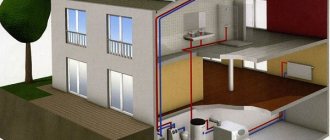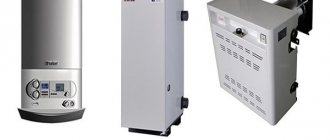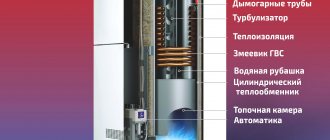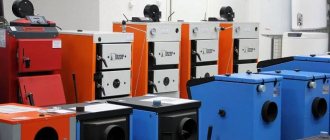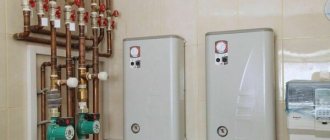Today, the most common type of heating systems in your own home or cottage is a system using gas boilers, and its importance cannot be overestimated. Note: security requirements here are equally important, as are the necessary functionality and practicality.
What does someone who decides to install gas heating in their home need to know? Looking at photos of gas boilers in company price lists or on website pages will clearly not be enough.
But still, let's determine the points that you should pay close attention to when selecting a boiler for gas heating, since it is the key element of the entire system.
Gas boilers for home heating
A gas boiler is a complex device used to generate thermal energy. It is used for heating various types of objects and the process of heating coolants. This is an affordable, convenient and popular type of heat generator. Propane-butane or methane is used as fuel.
When choosing a gas boiler for heating a private home, you should familiarize yourself with the available information and analyze it.
A variety of installation methods, design features and differences in equipment types provide a wide range to suit all use cases. It’s not easy to understand the variety of products offered, but having an idea of the characteristics and parameters, you can choose the right option.
Hydraulic group
The hydraulic group is located at the very bottom of the device. This includes the supply part and the return part (with a pump).
Please note what materials this group is made of. Previously, brass was common.
Nowadays it is increasingly being replaced by a composite version - heat-resistant black plastic. There is nothing wrong with this, technology does not stand still and develops every day.
Mistake #22
However, brass is still considered a higher quality and more reliable material.
At the same time, many people forget that if the water in your system is chemically aggressive + there are stray currents, then a boiler with a brass hydraulic group will not be the best solution.
Operating principle of a gas boiler
From a specialist’s point of view, the equipment operation system is simple and reliable. The device is installed and connected to the gas supply.
- Fuel is supplied to the unit and piezo or electric ignition is activated.
- The pilot burner lights and heats the water or antifreeze in the heat exchanger.
- The elements and assemblies of consumers are heated.
- If the heating system does not work, the automation immediately cuts off the gas supply.
After reaching the parameters set by the thermostat, the burner stops operating. When the temperature drops to the set value, the sensor is triggered and the system resumes operation.
Operating principle of AGV
The main structural element of the AGV is the container in which the coolant is heated. When gas burns, a heat exchanger, made in the form of a pipe and installed inside the AGV housing, heats up. The heat from the heated pipe is transferred to the coolant, which is subsequently sent to the heating circuit.
Gas combustion products are discharged through a chimney built into the boiler design. All automation is a valve that opens the gas burner. Thanks to the operation of the valve, the required temperature is constantly maintained in the tank.
AOGV boilers also have an automation unit that turns off the device in case of a number of problems:
- Traction disorder;
- Significant reduction in gas supply pressure;
- The igniter stops burning.
- Expansion tank;
- Heating devices located in each room requiring heating;
- Main pipeline providing distribution of heated coolant;
- Upper pipe distribution;
- Return pipe.
To know how an AOGV gas boiler works, you need to imagine the physical laws that arise in the heating system during its operation. The heated coolant has a lower density, which allows it to independently rise above the cold liquid. The coolant enters the main pipeline, is carried through the heating devices, gives off heat to them, and returns to repeat the heating cycle.
In AOGV boilers, the liquid moves by gravity, without any additional effort. If during the heating process the coolant expands too much, then its excess is drained into the expansion tank. This element is installed on the uppermost section of the heating circuit. When the temperature in the circuit decreases, the coolant returns to the OGV gas boiler.
To increase the efficiency of the system and make it more stable, you can supplement the AGV with a circulation pump, which forces the coolant to move forcibly and ensures more uniform heating of all sections of the circuit. It must be remembered that the pump requires electricity to operate - and the main advantage of the AGV is its independence from electricity.
Positive and negative qualities
This type of equipment is optimal if you have access to liquefied or main gas.
Advantages of a gas boiler
- Economical.
- Reliability.
- Autonomy.
- Durability.
- Easy to use.
- High performance.
- Possibility of placement in small rooms.
Disadvantages of a gas boiler
- Compliance of the premises with technical requirements.
- The need to obtain special documents permitting installation.
- Installation, connection and maintenance are carried out by specialists.
- For smooth operation, constant access to fuel is required.
Conclusion
Gas heaters with a power of 3 to 5 kW are distinguished by the absence of electronics, which allows the equipment to be used in village houses. The owner can use a standard boiler with a single or double circuit, but to reduce fuel consumption it is necessary to reduce the heating performance. The units are equipped with electronic flame modulation units and control panels with a display; to ensure operation, they require a connection to the electrical network and a chimney to remove combustion products.
How to choose a gas boiler
An individual heating system is the most preferable for use in your home. The variety of offers currently available makes it difficult to choose.
To understand which gas boiler is best for heating a private home, it’s worth spending a little time. This will help determine the truly suitable option.
Wall or floor option
The first lighter and more compact models. They can be placed in the bathroom or kitchen. They have low power and do not allow heating large areas. Weight does not exceed 70-80 kg.
- The floor-standing version is larger, weighs more and costs more.
- Most devices have an open combustion chamber and require forced ventilation assembly.
- The product uses expensive materials.
- Preferred for use in large houses. The service life of such a device is from 50 years.
Circulation pump
Here look at the brand of the pump. Brands that have proven themselves only from a positive point of view:
- Grundfos
- Wilo
If they are the ones inside, then this is a good choice.
At the same time, Wilo pumps are more demanding on the quality of the coolant, and can quickly “die” due to frequent refills and sludge. Grundfoss is more persistent in this regard.
With other unknown brands you need to be more wary.
Mistake #23
Just don’t confuse the situation when manufacturers write their brand on the end of the pump in large letters, but use the same Grundfos or Wilo.
This is a common practice among Vaillant. In this case, look for small print on the nameplate or on a separate sticker on the side.
A good seller must indicate the true manufacturer of the pump.
What is better: a single or double-circuit boiler?
A model with one circuit is designed for heating a room. To operate the hot water supply, you need to purchase and install an indirect heating boiler.
A dual-circuit device has two heat exchangers. They are connected to heating and hot water supply lines independent from each other.
Gas boiler power calculation
To heat a home with an area of 200 square meters, you will need a 20 kW boiler. Based on 1 kW per 10 square meters of area. If we take into account the margin of 20%, then the final result is 25 kW.
The best gas boiler for heating and supplying hot water to a small house is a double-circuit one with wall mounting.
Rating table
- Rank/Name
- Expert assessment
- Price range RUR
| Inexpensive wall-mounted boilers | ||
| 1: Lemax Patriot | 99 out of 100 | From 18,400 to 18,424 |
| 2: Oasis BM-18 | 97 out of 100 | From 25,190 to 26,300 |
| 3: Mizudo M24T | 86 out of 100 | From 32,200 to 33,555 |
| 4: BaltGaz SL 17 T | 86 out of 100 | From 18,500 to 19,500 |
| The best mounted convection boilers | ||
| 1: Buderus Logamax UO72-12K | 96 out of 100 | From 32,445 to 32,750 |
| 2: BOSCH Gaz 6000 W | 94 out of 100 | From 32,450 to 48,000 |
| 3:BAXI ECO-4s 24F | 92 out of 100 | From 31,570 to 33,120 |
| Wall-mounted condensing boilers | ||
| 1: Protherm lynx 25/30 MKV | 99 out of 100 | From 63,400 to 64,123 |
| 2: Vaillant ecoTec plus VU INT IV 346/5-5 | 98 out of 100 | From 112,830 to 115,889 |
| 3:BAXI LUNA Duo-tec 40 | 94 out of 100 | From 79,620 to 81,850 |
| TOP 3 floor-standing single-circuit boilers | ||
| 1: Lemax Clever 20 | 99 out of 100 | From 29,134 to 38,150 |
| 2: Siberia 17 17.4 | 90 out of 100 | From 22,356 to 24,987 |
| 3:BAXI SLIM 1.230 IN | 98 out of 100 | From 56,250 to 56,710 |
| Floor-standing condensing boilers | ||
| 1: Ferroli Quadrifoglio B 70 | 99 out of 100 | From 278 313 |
| 2:BAXI POWER HT 1.650 | 98 out of 100 | From 179,000 |
| 3: Fondital Giava KRB 24 | 96 out of 100 | From 367,618 to 417,754 |
| Inexpensive floor-standing double-circuit boilers | ||
| 1: ATON Atmo 10EBM | 99 out of 100 | From 20,500 to 21,690 |
| 2: Lemax Premium-30B | 97 out of 100 | From 31,300 to 33,120 |
| 3: Navien GA 35KN | 78 out of 100 | From 36,025 to 36,990 |
| Floor-standing boilers with built-in boiler | ||
| 1: Protherm Bear 30KLZ | 994 out of 100 | From 140,529 to 144,680 |
| 2: Ferroli Pegasus D 40 | 98 out of 100 | From 192,890 to 194,400 |
| 3: ACV HeatMaster 45 TC | 96 out of 100 | From 527,700 to 531,140 |
Boiler installation
Installation of specialized gas equipment must be carried out by professionals. And connection and commissioning by gas service workers. The assembly is carried out in accordance with the requirements of SNiP and is required to ensure the safety of the work and subsequent use by the consumer.
The price of gas boilers for home heating starts from 22 thousand rubles and can reach several hundred thousand, depending on the manufacturer, configuration and technical characteristics.
Prices for installation of equipment depend on the volume of work, the complexity of its implementation and the materials used
Gas tariffs in the Moscow region 2022
According to the latest data from the Committee on Prices and Tariffs of the Moscow Region dated June 20, 2018, the following tariffs for the population are established:
| p/p | Directions for gas use | Unit | Prices (including VAT) |
| 1 | Cooking and heating water using a gas stove (in the absence of other uses of gas | rub./cub. m | 6,35 |
| 2 | Cooking and heating water using a gas stove and heating water using a gas water heater in the absence of a central hot water supply (in the absence of other uses of gas) | rub./cub. m | 5,61 |
| 3 | Heating with the simultaneous use of gas in the areas specified in paragraphs 1, 2 of this Price List | rub / 1000 cubic meters m | 5 523,00 |
| 4 | Individual (apartment-by-apartment) heating of residential premises (residential buildings, apartments, rooms) in excess of the standard standard area of living premises in the absence of gas meters | rub / 1000 cubic meters m | 6 632,00 |
| 5 | Heating of non-residential premises in the absence of gas meters | rub / 1000 cubic meters m | 6 638,00 |
| 6 | Heating and (or) generation of electrical energy using boiler houses of all types and (or) other equipment that are in common shared ownership of the owners of premises in apartment buildings | rub / 1000 cubic meters m | 5 362,00 |
Notes:
- The heated area of residential premises (residential buildings, apartments, rooms) does not include the area of warm attics and basements, basements (undergrounds), cold, unheated verandas, balconies, loggias, terraces, as well as a cold attic or part thereof not occupied as an attic;
- When calculating fees for the use of natural gas in residential premises (residential buildings, apartments, rooms) not equipped with gas meters, one should be guided by the Decree of the Moscow Region Government dated November 9, 2006 No. 1047/43 “On approval of standards for natural gas consumption by the population in the absence of meters gas metering";
- In residential premises (residential buildings, apartments, rooms), in the absence of permanent residents and gas meters, payments for the use of natural gas for heating purposes are made at the prices specified in paragraph 4 of the table “Prices for natural gas sold to the public” , as well as housing maintenance organizations, organizations managing apartment buildings, housing construction cooperatives and homeowners’ associations for household needs (except for gas for tenants of non-residential premises in residential buildings)”;
- The size of the standard standard area of residential premises used when calculating payments for the use of natural gas for heating purposes is established by the Law of the Moscow Region No. 120/2009-03 “On the standard standard area of residential premises for the provision of subsidies and the provision of social support measures to certain categories of citizens for payment of housing premises and utilities in the Moscow region";
- The price for natural gas takes into account the costs of localizing emergency situations, except those that occurred through the fault of the subscriber;
- The price of natural gas does not include the cost of maintenance and repair of gas equipment in buildings and household gas-using equipment, as well as the cost of turning off and turning on household gas-using equipment;
- The price of natural gas does not include the commission charged by banks and payment systems for services for accepting payments from the public.
That is, the cost of natural gas will be about 5-6 rubles per cubic meter. Thus, it is not difficult to calculate that to heat a small cottage or country house in winter you will have to spend only a few thousand rubles a month, which is comparable to the cost of housing and communal services in an apartment. And in the summer, this expense item will be completely absent or insignificant.

